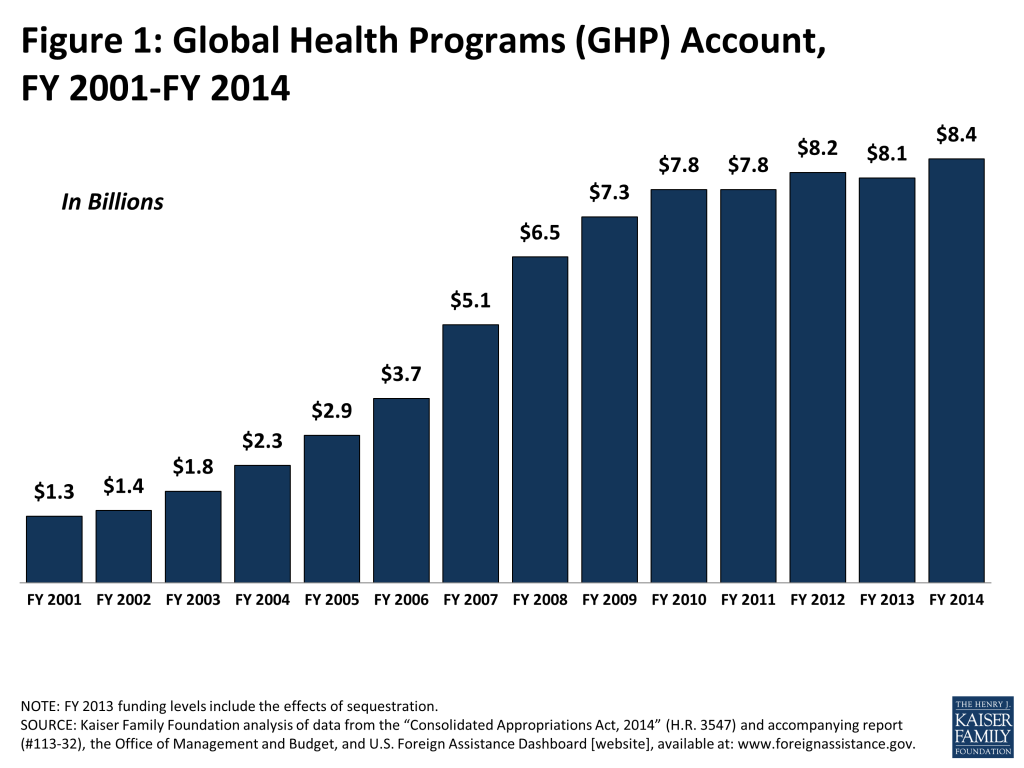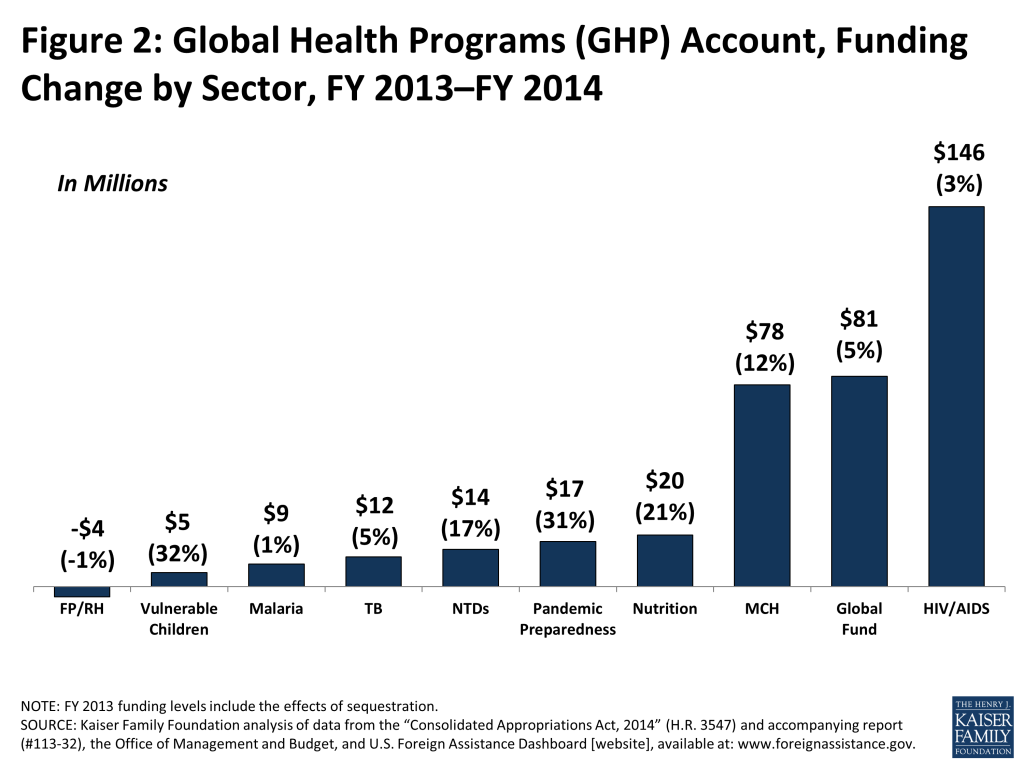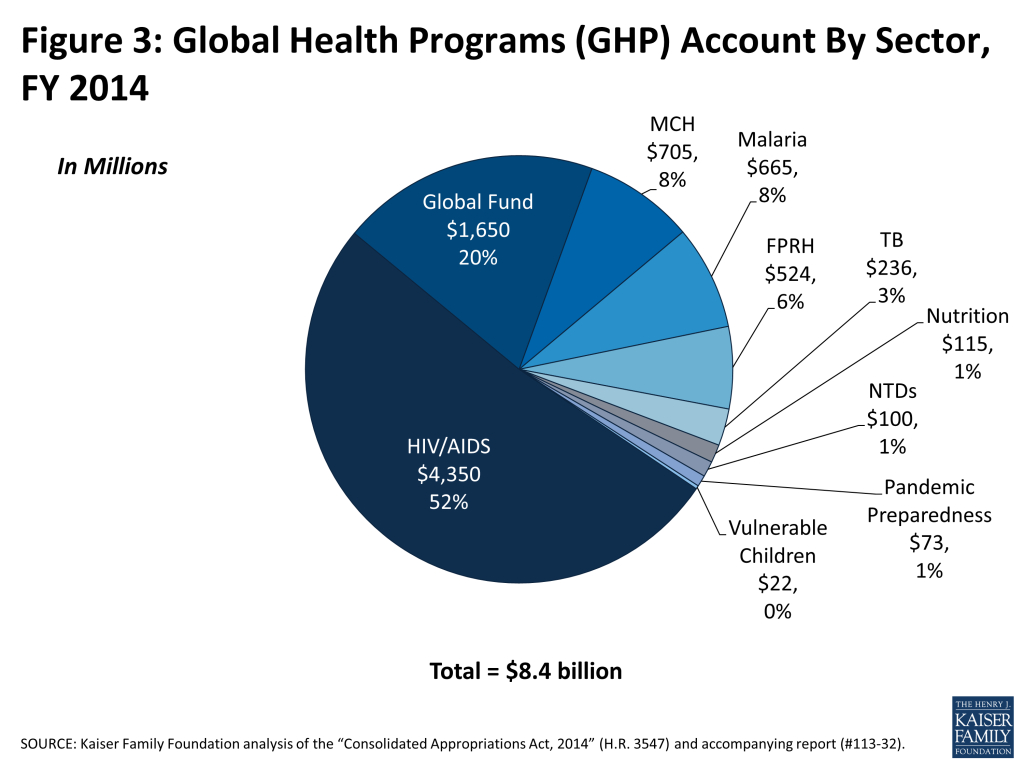The U.S. Global Health Budget: Analysis of Appropriations for Fiscal Year 2014
Overview
The FY14 Omnibus Appropriations bill was signed into law by the President on January 17, 2014, with approximately $9.1 billion1 in U.S. funding for global health programs, its highest historical level, though global health funding represents less than 1% of the overall federal budget. Global health funding in FY14 increased by more than $400 million (5%) above FY13 post-sequestration levels (sequestration mandated an approximate 5% decrease from enacted levels to most discretionary programs, projects, and activities in FY13). Most of this funding ($8.4 billion) is provided through the Global Health Programs (GHP) account at USAID and the State Department (see Table 1).
Within the GHP account, all programs received funding increases, with the exception of Family Planning and Reproductive Health (FP/RH), which declined slightly. Bilateral HIV funding, as part of PEPFAR, received the largest dollar increase ($146 million), followed by the Global Fund to Fight AIDS, Tuberculosis and Malaria ($81 million), and Maternal and Child Health (MCH) programs ($78 million).

Looking more broadly at funding trends over time (focusing on the GHP account), increased funding for global health has been relative modest in recent years (rising 3% between 2012 and 2014, for example), after the substantial increases of the prior decade (see Figure 1). This was similar to the rate of growth in federal funding for other non-defense, discretionary spending over the same recent period (2%).2
The summary below provides an overview of global health funding levels by program area as specified in the FY14 Omnibus Appropriations bill.3
PEPFAR/Bilateral HIV

PEPFAR’s bilateral HIV funding through the GHP account totaled $4,350 million ($330 million at USAID and $4,020 at the State Department), an increase of $146 million (3%) above FY13, demonstrating the largest increase among all areas (Figure 2). Bilateral HIV accounts for the largest share (52%) of the global health portfolio under the GHP account (Figure 3). The Omnibus bill also provided $114 million in HIV funding through the Centers for Disease Control and Prevention (CDC), a $3 million (3%) increase above FY13, and $8 million in funding for HIV programs at the Department of Defense (DoD), which matches the FY13 level. Additional funding for HIV research activities at the National Institutes of Health (NIH) is not yet known.
Global Fund to Fight AIDS, Tuberculosis and Malaria (Global Fund)

The Omnibus bill included $1,650 million for the U.S. contribution to the Global Fund, an $81 million (5.2%) increase above FY13 and the second largest increase among all areas. The Global Fund accounts for the second largest share (20%) of global health funding (in the GHP account).
Tuberculosis
Tuberculosis funding through the GHP account totaled $236 million, a $12 million (5%) increase above FY13. Additional tuberculosis funding provided through the Economic Support Fund (ESF) account is not yet known.
Malaria
Malaria funding through the GHP account totaled $665 million, a $9 million (1%) increase above FY13. Additional malaria funding through the CDC and for research activities at the NIH are not yet known.
Family Planning & Reproductive Health (FP/RH)
FP/RH funding through the GHP account totaled $524 million and was the only program area under the GHP account that declined from FY13 levels (-$4.0 million or -1%). However, Congress stated in the Omnibus bill that total bilateral funding for FP/RH programs should be “not less than $575 million” ($524 million through the GHP account and $51 million through the ESF account) and included an additional $35 million for the U.S. contribution to the United Nations Population Fund (UNFPA), essentially matching final FY13 funding levels ($610 million). While the Omnibus bill maintains existing policy requirements prohibiting the use of foreign assistance to pay for the performance of abortion as a method of family planning or to motivate or coerce any person to practice abortion, it does not include a reinstatement of the “Global Gag Rule”, which required foreign NGOs to certify that they would not perform or promote abortion as a method of family planning using funds from any source as a condition for receiving U.S. funding, nor does it prohibit funding for needle exchange programs – provisions that had been included in the House SFOPs appropriations bill.
Maternal & Child Health (MCH)
In FY14, MCH funding through the GHP account totaled $705, an increase of $78 million (12%) above FY13 and the third largest increase among all areas. Some additional MCH funding provided through other accounts is not yet known. Specific components of MCH funding include:
- GAVI: The U.S. contribution to GAVI, which is included under MCH funding in the GHP account, totaled $175 million, a $37 million (27%) increase above FY13.
- Polio: U.S. funding for polio programs is provided through USAID (via the GHP and ESF accounts) and CDC. Polio funding through USAID totaled $59 million ($51 million from GHP and $8 million from ESF), an increase of $15 million (34%) above FY13. Polio funding through the CDC totaled $146 million, an increase of $41 million (38%) above FY13 (polio accounted for more than 75% of the entire increase in CDC global health funding).4
- United Nations Children’s Fund (UNICEF): The U.S. contribution to UNICEF totaled $132 million in FY14, a $7 million (5%) increase above FY13.5 The House SFOPs appropriations bill had eliminated funding for several United Nations entities including UNICEF.
Nutrition
Nutrition funding through the GHP account totaled $115 million, a $20 million (21%) increase above FY13. Additional nutrition funding provided through other accounts, such as the ESF account, is not yet known.
Vulnerable Children
Funding for vulnerable children, which is provided via the Displaced Children and Orphans Fund (DCOF), totaled $22 million in the GHP account, a $5 million (32%) increase above FY13. The increase in funding for vulnerable children was the largest percentage increase among all areas under the GHP account.
Pandemic Preparedness
Pandemic Preparedness funding through the GHP account totaled $73 million, an increase of $17 million (31%) above FY13. The increase in pandemic preparedness funding was the second largest percentage increase among all areas under the GHP account. Additional funding provided through other accounts, such as the ESF account, is not yet known.
Other Non-Global Health Funding
The Omnibus bill also provided funding for areas and agencies that are not directly involved in U.S. global health, but are related and may impact these efforts including the Millennium Challenge Corporation (MCC), Feed the Future (FtF), which is the U.S. Government’s Global Hunger and Food Security Initiative, broader food assistance through Food for Peace and McGovern-Dole International Food for Education and Child Nutrition, and other funding through the State & Foreign Operations Development Assistance (DA) and Economic Support Fund (ESF) accounts. Within the Omnibus bill, funding for all of these areas increased above FY13 levels with the exception of the overall DA and ESF accounts; the DA account declined by more than $200 million (-8%) and the ESF account declined by almost $1 billion (see Table 2). The ESF decrease, however, is entirely attributed to decreases in funding for Overseas Contingency Operations (OCO), which provides funding for programs in Iraq, Afghanistan, and Pakistan; non-OCO funding in the ESF account actually increased.
- This total represents funding amounts identified in the bill. Additional funding for some global health programs at USAID and the National Institutes of Health (NIH) is determined at the agency level and is therefore not yet available. ↩︎
- Note: Does not include funding for Overseas Contingency Operations (OCO) or other emergency funding. Analysis of data from: the House of Representatives Committee on Appropriations, January 13, 2014, http://appropriations.house.gov/uploadedfiles/fy14_omnibus_-_informational_graphs.pdf; CBO, Estimate of Discretionary Appropriations for Fiscal Year 2014, Including H.R. 3547, the ConsolidatedAppropriations Act, 2014, as Posted on the Website of the House Committee on Rules on January 13, 2014, http://www.cbo.gov/sites/default/files/cbofiles/attachments/hr3547.pdf; CRS, Defense: FY2014 Authorization and Appropriations, January 8, 2014, http://www.fas.org/sgp/crs/natsec/R43323.pdf; DoD, National Defense Budget Estimates for FY 2014, May 2013, http://comptroller.defense.gov/defbudget/fy2014/FY14_Green_Book.pdf ↩︎
- Unless otherwise specified, all totals refer to funding amounts under the GHP account. All comparisons are to FY13 post-sequestration levels. ↩︎
- A realignment of CDC funding for business services that was included in the President’s FY 2014 Budget Request is not included in these totals. ↩︎
- U.S. funding for UNICEF is provided through the International Organizations and Programs (IO&P) account. ↩︎